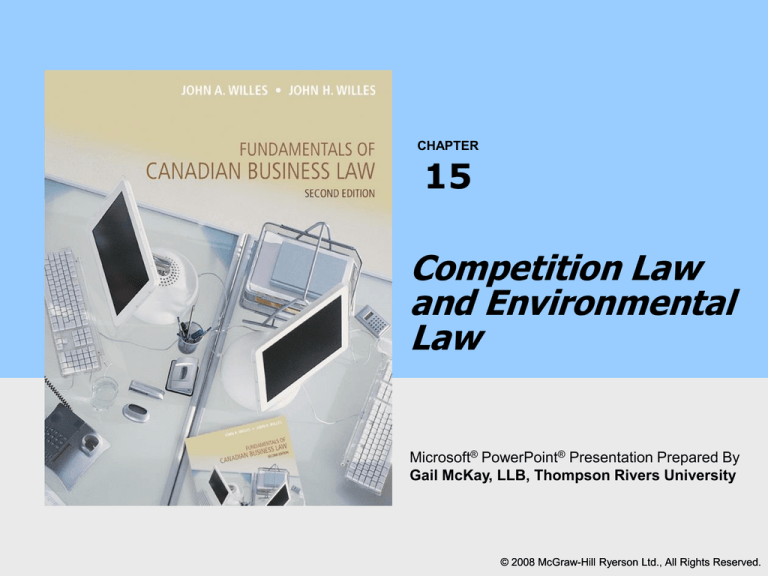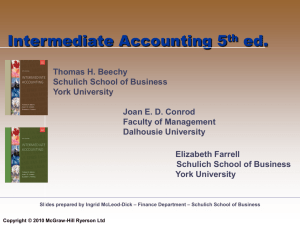
CHAPTER
15
Competition Law
and Environmental
Law
Microsoft® PowerPoint® Presentation Prepared By
Gail McKay, LLB, Thompson Rivers University
© 2008 McGraw-Hill Ryerson Ltd.
Ltd., All Rights Reserved.
OBJECTIVES
1. To examine government regulation of
business competition
2. To appreciate the increasing legal
responsibility of business operations to the
natural environment
Fundamentals of Canadian Business Law, Second Edition
© 2008 McGraw-Hill Ryerson Ltd. All Rights Reserved.
15-1
INTRODUCTION TO COMPETITION LAW
Historically, governments have gradually
made their presence felt in the world of
business – first in terms of overseeing the
general working conditions which employers
might impose on employees, and then in terms
of inroads into the regulation of child labour
During the 20th century, consumer protection
legislation was enacted to provide implied
warranties and conditions regarding the sale of
goods for personal use
Fundamentals of Canadian Business Law, Second Edition
© 2008 McGraw-Hill Ryerson Ltd. All Rights Reserved.
15-2
INTRODUCTION, continued
The federal government next authored an
initiative to curb the anticompetitive practices
and unfair business tactics of some large
corporations by enacting the Competition Act
Further, the Food and Drug Act now regulates
the safety of food, and the Hazardous Products
Act governs the handling of hazardous
products, setting minimum safety standards
for certain products
Interprovincial and international regulation of
business activity is also a federal responsibility
Fundamentals of Canadian Business Law, Second Edition
© 2008 McGraw-Hill Ryerson Ltd. All Rights Reserved.
15-3
INTRODUCTION, continued
Most business laws are provincial or
territorial, including
The Sale of Goods Act
The Labour Relations Act
The Employment Standards Act
The Partnership Act
The Business Corporations Act
The Consumer Protection Act
The Business Practices Act
and human rights and insurance legislation
Fundamentals of Canadian Business Law, Second Edition
© 2008 McGraw-Hill Ryerson Ltd. All Rights Reserved.
15-4
COMPETITION LAW
The goal of the Competition Act is to
maintain and encourage business competition
in keeping with the belief that free enterprise
and competition should regulate industry and
will best serve the public interest
Abuse of a dominant market position through
mergers, secret combinations or conspiracies
to raise prices and profits, and misleading
product promotion are all activities regarded as
anticompetitive behaviours
Fundamentals of Canadian Business Law, Second Edition
© 2008 McGraw-Hill Ryerson Ltd. All Rights Reserved.
15-5
COMPETITION LAW, continued
The following unfair trade practices have
been made criminal offences under the
Competition Act:
1.
2.
3.
4.
5.
Resale price maintenance
Price discrimination
Discriminatory promotional allowances
False advertising
Bid rigging
Fundamentals of Canadian Business Law, Second Edition
© 2008 McGraw-Hill Ryerson Ltd. All Rights Reserved.
15-6
NATURE OF THE LEGISLATION
The Competition Act brings criminal law,
administrative law and civil law perspectives
and approaches to regulating the restraint of
trade, including the array of remedies from
each – although in business, bad publicity may
be the most condign punishment
Powers of search and seizure and the right to
compel directors and officers to give evidence
are part of the investigative authority invested
in the Commissioner of Competition
Fundamentals of Canadian Business Law, Second Edition
© 2008 McGraw-Hill Ryerson Ltd. All Rights Reserved.
15-7
Fundamentals of Canadian Business Law, Second Edition
© 2008 McGraw-Hill Ryerson Ltd. All Rights Reserved.
15-8
THE COMPETITION TRIBUNAL
After complaints of violations from six or
more residents of Canada and the attaining of
a search warrant, if the Commissioner finds
evidence of a violation he or she may deliver it
to the Attorney General or the Competition
Tribunal
The Competition Tribunal may examine
reviewable practices - such as market
restriction, exclusive dealing, tied selling,
consignment selling, refusal to supply goods,
abuse of dominant position and mergers
Fundamentals of Canadian Business Law, Second Edition
© 2008 McGraw-Hill Ryerson Ltd. All Rights Reserved.
15-9
Fundamentals of Canadian Business Law, Second Edition
© 2008 McGraw-Hill Ryerson Ltd. All Rights Reserved.
15-10
RESTRICTIVE TRADE PRACTICES
There are three categories of restrictive
trade practices:
1. Practices that are related to the nature of
the firm itself (dominance and mergers)
2. Practices that arise from dealings between a
firm and its competitors (conspiracies)
3. Practices that arise from dealings between a
firm and its customers (discrimination)
Fundamentals of Canadian Business Law, Second Edition
© 2008 McGraw-Hill Ryerson Ltd. All Rights Reserved.
15-11
MERGERS AND DOMINANT FIRMS
When a company’s assumption of a
dominant position in the market is determined
to be a detriment to the public, the
Competition Act may be used to review and
intervene
If a merger has resulted in one business
having more than half of the market share, it
might be subject to scrutiny from the
Commissioner
Fundamentals of Canadian Business Law, Second Edition
© 2008 McGraw-Hill Ryerson Ltd. All Rights Reserved.
15-12
DEALINGS BETWEEN COMPETITORS
Conspiracies and combinations (dealings
between firms) which lessen competition
unduly may amount to indictable offences
under section 45 of the Competition Act
If the Crown can show beyond a reasonable
doubt that firms intentionally engaged in
activity to unduly restrict competition, or had
the effect of unduly restricting competition,
they may be subject to up to five years in
prison, fines of up to $10,000,000, or both
Fundamentals of Canadian Business Law, Second Edition
© 2008 McGraw-Hill Ryerson Ltd. All Rights Reserved.
15-13
CONSPIRACY LIABILITY: EXEMPTIONS
1. Exchange of statistics
2. Defining product standards
3. Exchange of credit information
4. Definition of terms in a trade or industry
5. Co-operation in research and development
6. Restriction of advertising or promotion
7. Container sizes or shapes for packaging
8. Adoption of metric system
9. Measures to protect the environment
If only one of these subjects is discussed, an
exemption to a finding of conspiracy is granted
Fundamentals of Canadian Business Law, Second Edition
© 2008 McGraw-Hill Ryerson Ltd. All Rights Reserved.
15-14
OTHER EXEMPTIONS
The Competition Act applies only to
domestic conspiracies or combinations, and not
to the export of goods from Canada
If the arrangement relates only to standards of
competency and integrity in the practice of
professional services or a trade, or to the
negotiation of a contract for professional sport,
an exemption is again created
Parent corporations which are affiliated with a
subsidiary are exempt from these restrictions
Fundamentals of Canadian Business Law, Second Edition
© 2008 McGraw-Hill Ryerson Ltd. All Rights Reserved.
15-15
DEALINGS WITH CUSTOMERS
The Competition Act creates offences
related to the distribution of goods such as:
Granting special concessions to large buyers
Granting special rebates or promotional
allowances unless done proportionally
Offering reduced prices in some geographical
areas
Attempting to influence the price of goods
when they will be resold by the purchaser
When a purchaser, however, consistently
engages in loss leader selling of the goods, the
seller may legally refuse to sell to him or her
Fundamentals of Canadian Business Law, Second Edition
© 2008 McGraw-Hill Ryerson Ltd. All Rights Reserved.
15-16
REVIEWABLE ACTIVITIES
Reviewable activities include methods of
selling such as tied selling, exclusive dealing,
consignment selling, abuse of dominant
position, refusal to supply goods, and market
restriction or foreign directives
Foreign directives in restraint of trade include:
Impeding entry or expansion of a firm
Impeding the production of a product
Impeding the expansion of sales of a product
Having any other exclusionary market effect
Fundamentals of Canadian Business Law, Second Edition
© 2008 McGraw-Hill Ryerson Ltd. All Rights Reserved.
15-17
PROMOTION & ADVERTISING: OFFENCES
Misleading advertising is any material
misrepresentation to the public that is false or
misleading about products or prices
A seller in a specific region is expected to sell
to everyone in the region at the advertised
price, and if there is more than one ticket on
an item, at the lowest of the prices
Bait and switch involves advertising goods at a
bargain price to attract customers but without
sufficient quantities to sell, and then urging the
customer to buy a more expensive model
Fundamentals of Canadian Business Law, Second Edition
© 2008 McGraw-Hill Ryerson Ltd. All Rights Reserved.
15-18
CIVIL ACTIONS: THE COMPETITION ACT
A civil lawsuit for restraint of trade may be
brought under the common law for activities
not covered by the Competition Act, for a
plaintiff who had been injured as a result of the
defendant’s breach of the Competition Act, or
for a plaintiff injured because of a defendant’s
violation of a Competition Tribunal order
The victim of a common law breach may
receive damages for actual loss if he or she is
able to meet the civil standard of proof – on a
balance of probabilities
Fundamentals of Canadian Business Law, Second Edition
© 2008 McGraw-Hill Ryerson Ltd. All Rights Reserved.
15-19
ENVIRONMENTAL LAW
Environmental law attempts to create a
balance between individual or business rights
to the use of the environment and the general
need to protect it
The 1997 Kyoto Protocol is a commitment by
Canada to reduce greenhouse gas emissions by
six percent below 1990 levels between 2008
and 2012
In 2007, the federal government refocused
spending on domestic projects; the Clean Air
Act is presently at the stage of first reading
Fundamentals of Canadian Business Law, Second Edition
© 2008 McGraw-Hill Ryerson Ltd. All Rights Reserved.
15-20
THE COMMON LAW
The perspective of the common law in the
environmental realm provides that the conduct
of one person or business may not significantly
interfere with another’s right to use and enjoy
his or her own property
A claim in the tort of nuisance allows an
individual to seek an award of damages for
interference such as pollution of a stream or
river causing injury to a downstream user,
contamination of soil or groundwater,
contamination of property from particles in
smoke, and sometimes for excessive noise
Fundamentals of Canadian Business Law, Second Edition
© 2008 McGraw-Hill Ryerson Ltd. All Rights Reserved.
15-21
WEAKNESSES IN THE COMMON LAW
Nuisance law is geared toward the protection
of private property rights rather than toward
public protection of the environment itself
Further problems include the fact that
environmental groups often cannot establish
standing before the courts because they have
not personally suffered injury, that it is often
difficult to pinpoint the actual source of
ongoing environmental degradation, and that
the common law scope of remedies does not
include cleanup of the source of the pollution
on the polluter’s own property
Fundamentals of Canadian Business Law, Second Edition
© 2008 McGraw-Hill Ryerson Ltd. All Rights Reserved.
15-22
ENVIRONMENTAL LEGISLATION
Legislation regulates conduct that has a
negative impact on the environment
Federal, provincial and territorial governments
have enacted environmental protection
legislation which regulates business activities
respecting the discharge of harmful substances
into the air and water – often specifying the
exact quantity (parts per million in a specific
volume) of a pollutant that can be discharged
during a particular period of time
Fundamentals of Canadian Business Law, Second Edition
© 2008 McGraw-Hill Ryerson Ltd. All Rights Reserved.
15-23
ENFORCEMENT
Some legislation requires a business to
monitor itself and record its discharge, making
sure its allowable limits are not exceeded;
otherwise, its licence may be revoked
Enforcement officers have the authority to
inspect and monitor businesses for compliance
and can issue an order to cease operations
until serious pollution problems are corrected;
however, when the polluter is the major or sole
employer in a town, such a decision is laden
with all manner of complexity
Fundamentals of Canadian Business Law, Second Edition
© 2008 McGraw-Hill Ryerson Ltd. All Rights Reserved.
15-24
ENVIRONMENTAL ASSESSMENTS
If a planned government undertaking
could cause a serious change to the
environment, a formal approval process must
be engaged
Technical studies regarding the impact of the
project on the environment must be shared
with the public, and the approval of interested
parties must be sought
Examples of such projects include the building
of dams, the flooding or drainage of wetlands
and the construction of waste disposal sites
Fundamentals of Canadian Business Law, Second Edition
© 2008 McGraw-Hill Ryerson Ltd. All Rights Reserved.
15-25
STORAGE AND SPILLS
The transportation or handling of
hazardous products is governed by the
Transportation of Dangerous Goods Act and
the Hazardous Products Act, and if a
contaminant is spilled, the polluter is generally
either directly or indirectly responsible for the
cost of cleanup
Corporate directors and officers can be found
personally liable under the Canadian
Environmental Protection Act unless they can
demonstrate due diligence including inspection
for risky situations, trained staff and follow up
Fundamentals of Canadian Business Law, Second Edition
© 2008 McGraw-Hill Ryerson Ltd. All Rights Reserved.
15-26
ENVIRONMENTAL RESPONSIBILITY
The business or person who caused
environmental damage may be long gone, and
often the current owner is found liable
Purchasers of property are well advised to
require that a “clean” environmental audit of
the land is a condition precedent to the
purchase, since the cost of cleanup may well
exceed the value of the real estate
Mortgagees taking possession of land after a
default may find themselves defined as
owners, and may be subject to cleanup costs
too, unless they have insisted on an audit
Fundamentals of Canadian Business Law, Second Edition
© 2008 McGraw-Hill Ryerson Ltd. All Rights Reserved.
15-27
ENVIRONMENTAL RESPONSIBILITY
An acceleration of a commitment toward
environmental responsibility and accountability
seems to have occurred recently, perhaps
precipitated by Al Gore’s documentary “An
Inconvenient Truth”
In their practices and procedures, businesses
should therefore not ignore the more
responsive and proactive attitudes and
behaviours now emerging toward the
protection of the environment
Fundamentals of Canadian Business Law, Second Edition
© 2008 McGraw-Hill Ryerson Ltd. All Rights Reserved.
15-28
SUMMARY
The Competition Act encourages and protects
competition in the free market
The statute provides criminal, administrative
and civil sanctions for restrictive trade
practices, abuse of a dominant position,
conspiracies and combinations, and false
advertising or promotion
Environmental protection is governed by
legislation and by nuisance law, with increasing
liability for corporate directors and officers and
higher expectations as to the meaning of due
diligence
Fundamentals of Canadian Business Law, Second Edition
© 2008 McGraw-Hill Ryerson Ltd. All Rights Reserved.
15-29




